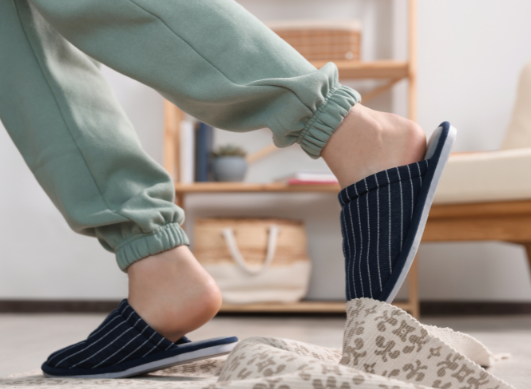Feeling clumsy, off-balance and disconnected from your body? It could be a sensory issue.
Published Nov 7, 2025 • By Somya Pokharna
Imagine constantly feeling unsteady or unsure of where your limbs are unless you’re watching them. This is the experience of many people with dysproprioception, a lesser-known sensory issue that affects balance and body awareness.
Dysproprioception isn’t a disease in itself, but a symptom that appears in chronic illnesses like multiple sclerosis, fibromyalgia, and long COVID. So, what causes it? How does it feel? And what can you do to cope?
This article answers those questions and more to help you better understand this invisible but frustrating experience.

What is dysproprioception?
Dysproprioception means having a reduced or distorted sense of where your body is in space. Proprioception, sometimes called your “sixth sense”, is what allows you to move without constantly looking at your limbs. When this sense is disrupted, the brain doesn’t receive accurate feedback from your joints and muscles.
As a result, your movements may feel clumsy, uncertain, or disconnected. You might misjudge distances, bump into things, or feel like you need to consciously focus on actions that used to be automatic, like walking or reaching for an object.
Dysproprioception is not a standalone condition. It’s a symptom caused by underlying issues affecting the nervous system or joints. This includes conditions like:
- Multiple sclerosis (MS)
- Peripheral neuropathy (e.g., from diabetes or long COVID)
- Fibromyalgia
- Joint hypermobility and Ehlers-Danlos syndrome (EDS)
What does dysproprioception feel like?
People with dysproprioception often describe feeling “off-balance” or “disconnected from their body.” It may show up as:
- Trouble walking without watching your feet
- Difficulty sensing limb position without visual cues
- Feeling unsteady in the dark or on uneven ground
- Frequent stumbling or knocking over objects
- Dizziness or disorientation because the brain isn’t getting accurate positional feedback
- A sensation of your body being “foreign” or unreliable
These symptoms can range from mild to severe. They often worsen with fatigue, illness, or stress, common features in many chronic conditions. Some people rely heavily on sight to compensate, which can be exhausting and limit independence.
What causes dysproprioception in chronic illness?
Dysproprioception is not limited to one illness, it can arise from a variety of injuries or chronic conditions that disrupt the body’s sensory feedback. Here are some common causes and associated conditions:
Neurological disorders
Damage to the central nervous system can impair proprioceptive pathways. For example, multiple sclerosis, an autoimmune disease that demyelinated nerves, often leads to proprioceptive deficits and sensory ataxia. People with MS may experience numbness and loss of position sense in their limbs, contributing to balance problems and falls. Other neurodegenerative diseases like Parkinson’s disease and Huntington’s disease can also affect proprioception.
Peripheral neuropathy
Any condition that damages the peripheral nerves (which carry signals from joints and muscles to the brain) can cause dysproprioception. Diabetic neuropathy is a prime example: when nerve fibers in the legs are damaged, patients may lose sensation of foot position. Similarly, long COVID (post-COVID syndrome) has been linked to peripheral nerve damage and small fiber neuropathy in some patients. Emerging research indicates that people with long COVID can have measurable deficits in balance and proprioception, likely due to sensory nerve dysfunction. These patients might become overly reliant on vision for balance or feel more unsteady on their feet in complex environments.
Joint or musculoskeletal conditions
Proprioceptors (sensors) in our joints and ligaments provide critical feedback. Thus, joint injuries or arthritis can locally impair proprioception (for instance, a badly sprained ankle often has reduced position sense even after healing). People with hypermobile joints or Ehlers-Danlos syndrome (EDS) frequently have chronic proprioceptive impairments because loose connective tissues don’t send clear signals about joint position. This leads to clumsiness and difficulty controlling movements.
Chronic pain and fibromyalgia
Fibromyalgia, a chronic pain syndrome, is associated with not just pain and fatigue but also subtle sensorimotor issues. Recent studies have found that people with fibromyalgia have poorer joint position sense in their limbs and greater postural instability than healthy peers. In other words, fibromyalgia can come with dysproprioception, possibly due to altered sensory processing or deconditioning. This may explain why many fibromyalgia patients report balance troubles or fear of falling.
Sensory processing disorders
Conditions like autism spectrum disorder (ASD) and developmental coordination disorder (dyspraxia) can involve proprioceptive dysfunction as well. Although these are different in nature from acquired neuropathies, children or adults with sensory processing differences might appear clumsy, seek extra sensory input (e.g. tight hugs or weighted blankets), or have trouble knowing where their body is in space. These signs reflect an impaired integration of proprioceptive signals.
Ageing
Even without a specific diagnosis, proprioception tends to decline with age. As joints degenerate and peripheral nerves slow down, older adults often have worse balance and are at higher risk of falls, partly due to reduced proprioceptive acuity.
How does dysproprioception affect daily life?
Dysproprioception can interfere with everyday activities in subtle but frustrating ways:
Balance and mobility
Perhaps the most immediate impact is on walking and standing. People with significant proprioceptive loss may walk more cautiously, keep their eyes on the ground or their feet, and avoid walking in the dark. Without visual cues, they might lose balance quickly. Even with eyes open, walking on uneven surfaces (grass, sand, or stairs) becomes a mental task because the normal “automatic” balance adjustments are unreliable. This often leads to anxiety about falling.
Coordination
Dysproprioception can turn simple tasks into careful exercise. You might knock over a drink when reaching for it because your hand’s trajectory was off. Dressing can be tricky: inserting limbs into sleeves, buttoning shirts, or tying shoelaces without looking may require extra time or multiple attempts. Fine motor tasks like typing or writing can suffer; for instance, you might press too hard with a pen or have sloppy handwriting because you aren’t getting proper feedback from your fingers.
Body awareness and confidence
A less tangible but important impact is on one’s confidence in movement. When you can’t trust your body’s position sense, it can feel alienating. Some people feel disembodied or disconnected, as if their body is “not them.” This can affect one’s identity and comfort in daily life, leading to frustration or even emotional distress. You may avoid certain activities you used to enjoy (sports, driving, hiking) out of fear of injury or embarrassment.
Fatigue
Because the brain works harder to compensate for lost feedback, mental fatigue is common. What used to be automatic movements, like walking across a room or picking up a mug, may now require intense focus and visual monitoring. The cognitive load builds up over the day and can leave you feeling drained, even without doing anything physically demanding.
How can dysproprioception be managed or improved?
There is no single “cure” for dysproprioception, especially when it stems from chronic conditions, but there are multiple strategies to help improve proprioceptive function and maintain safety:
Get assessed
Talk to your doctor if you notice unexplained balance issues, clumsiness, or strange sensations. They may evaluate your proprioception as part of a neurological or physical exam.
Work with a physiotherapist or occupational therapist
Physical therapists can guide you through exercises to improve proprioceptive awareness, balance, and joint position sense. These might include:
- Balance training (e.g., standing on one leg, using wobble boards)
- Closed-eye movement practice
- Strengthening exercises to stabilize joints
Occupational therapists can also suggest home adjustments, new techniques, and assistive devices to make daily tasks safer and easier.
Use visual and tactile feedback
Since visual cues can partially replace lost proprioception, try watching the limbs during movement and keeping spaces well-lit. Tools like night lights and motion sensors improve nighttime safety. Some therapies use mirror exercises or virtual reality to help retrain body awareness. Tactile aids, such as compression garments or ankle braces, provide consistent skin pressure and extra feedback, which can subtly improve joint position sense and stability.
Try mind-body practices
Practices like tai chi, Pilates, or yoga emphasize slow, purposeful movements and can heighten body awareness over time. They also improve muscle strength and coordination, which support the proprioceptive system.
Treat the underlying condition
Managing the root cause, whether it’s MS, fibromyalgia, arthritis, or another condition, is essential. Effective treatment may reduce symptoms and support nervous system recovery.
Key takeaways
- Dysproprioception is a disruption in body awareness that causes balance and coordination issues.
- It often appears in chronic illnesses like MS, fibromyalgia, EDS, and long COVID.
- Symptoms include clumsiness, unsteadiness, and a disconnection from one’s body.
- Management includes therapy, visual/tactile compensation, safe home environments, and treating the underlying cause.
- With support and adaptation, many people learn to manage dysproprioception and regain confidence.
If you found this article helpful, feel free to give it a “Like” and share your thoughts and questions with the community in the comments below!
Take care!
Sources:
Cleveland Clinic. (2024). Proprioception: What it is, how to improve it & disorders. Cleveland Clinic Health Library.
Gervasoni, F., LoMauro, A., Ricci, V., Salce, G., Andreoli, A., Visconti, A., & Pantoni, L. (2022). Balance and visual reliance in post-COVID syndrome patients assessed with a robotic system: a multi-sensory integration deficit. Neurological sciences : official journal of the Italian Neurological Society and of the Italian Society of Clinical Neurophysiology, 43(1), 85–88.
Hamonet, C., & Ducret, L. (2019). Ehlers-Danlos, proprioception, dystonia, dysautonomy, L-Dopa and oxygenotherapy’s efficacy. Journal of Alzheimer’s & Neurodegenerative Diseases, 5, 031.
Kandakurti, P. K., Reddy, R. S., Alnakhli, H. H., Alkhamis, B. A., Koura, G. M., ALMohiza, M. A., Alyazedi, F. M., Mukherjee, D., & Rao, V. S. (2025). Joint-level proprioceptive deficits and postural instability in Fibromyalgia: a biomechanical assessment using digital inclinometry and dynamic posturography. Frontiers in bioengineering and biotechnology, 13, 1622679.
Kozinc, Ž., Žura, E., & Brecl Jakob, G. (2025). Postural sway in multiple sclerosis patients: Interaction of vision, surface, and fatigue effects. Frontiers in Human Neuroscience, 19, 1624969.
Winter, L., Huang, Q., Sertic, J. V. L., & Konczak, J. (2022). The effectiveness of proprioceptive training for improving motor performance and motor dysfunction: A systematic review. Frontiers in Rehabilitation Sciences, 3, 830166.
1 comment
You will also like

What are the dangers associated with the over-the-counter sale of certain medicines?
Dec 19, 2020 • 6 comments

 Facebook
Facebook Twitter
Twitter


